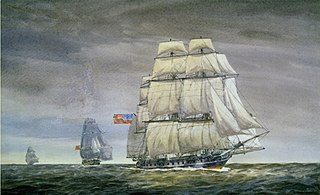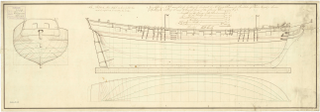
USS Adams was a 28-gun (rated) sailing frigate of the United States Navy. She was laid down in 1797 at New York City by John Jackson and William Sheffield and launched on 8 June 1799. Captain Richard Valentine Morris took command of the ship.
The first USS Virginia was a 28-gun sailing frigate of the Continental Navy, a ship with a short and unfortunate career.

Master Commandant William Henry Allen was an American naval officer during the War of 1812.

Chesapeake was a 38-gun wooden-hulled, three-masted heavy frigate of the United States Navy. She was one of the original six frigates whose construction was authorized by the Naval Act of 1794. Joshua Humphreys designed these frigates to be the young navy's capital ships. Chesapeake was originally designed as a 44-gun frigate, but construction delays, material shortages and budget problems caused builder Josiah Fox to alter his design to 38 guns. Launched at the Gosport Navy Yard on 2 December 1799, Chesapeake began her career during the Quasi-War with France and later saw service in the First Barbary War.

HMS Galatea was a fifth-rate 32-gun sailing frigate of the British Royal Navy that George Parsons built at Bursledon and launched in 1794. Before she was broken up in 1809 she captured numerous prizes and participated in a number of actions, first in the Channel and off Ireland (1794–1803), and then in the Caribbean (1802–1809), including one that earned her crew the Naval General Service Medal.

HMS Indefatigable was one of the Ardent-class 64-gun third-rate ships-of-the-line designed by Sir Thomas Slade in 1761 for the Royal Navy. She was built as a ship-of-the-line, but most of her active service took place after her conversion to a 44-gun razee frigate. She had a long career under several distinguished commanders, serving throughout the French Revolutionary Wars and the Napoleonic Wars. She took some 27 prizes, alone or in company, and the Admiralty authorised the issue of four clasps to the Naval General Service Medal in 1847 to any surviving members of her crews from the respective actions. She was broken up in 1816.

The United States Congress authorized the original six frigates of the United States Navy with the Naval Act of 1794 on March 27, 1794, at a total cost of $688,888.82. These ships were built during the formative years of the United States Navy, on the recommendation of designer Joshua Humphreys for a fleet of frigates powerful enough to engage any frigates of the French or British navies, yet fast enough to evade any ship of the line.
The second USS General Greene was a frigate in the United States Navy during the Quasi-War with France.

HMS Shannon was a 38-gun Leda-class frigate of the Royal Navy. She was launched in 1806 and served in the Napoleonic Wars and the War of 1812. She won a noteworthy naval victory on 1 June 1813, during the latter conflict, when she captured the United States Navy frigate USS Chesapeake in a singularly bloody battle.
USS Merrimack, was a ship launched by an Association of Newburyport Shipwrights and presented to the Navy in 1798. She was the first ship of the Navy to be named for the Merrimack River. She saw action in the Quasi-War.

HMS Fantome was an 18-gun brig-sloop of the Royal Navy. She was originally a French privateer brig named Fantôme, which the British captured in 1810 and commissioned into British service. Fantome saw extensive action in the War of 1812 until she was lost in a shipwreck at Prospect, Nova Scotia, near Halifax in 1814.

HMS Belvidera was a Royal Navy 36-gun Apollo-class frigate built in Deptford in 1809. She saw action in the Napoleonic Wars and the War of 1812 and continued a busy career at sea into the middle of the 19th century. In 1846 she was reduced to harbour service, in 1860 she became a receiving ship, and she was finally disposed of in 1906.
HMS Meleager was a 32-gun Amazon-class frigate' that Greaves and Nickolson built in 1785 at the Quarry House yard in Frindsbury, Kent, England. She served during the French Revolutionary Wars until 1801, when she was wrecked in the Gulf of Mexico.

HMS President was a large frigate in the British Royal Navy (RN). She was built to replace the previous HMS President, redesignated from the heavy frigate USS President built in 1800 as the last of the original six frigates of the United States Navy under the Naval Act of 1794. The first President had been the active flagship of the U.S. Navy until captured while trying to escape the Royal Navy blockade around New York in 1815 at the end of the War of 1812, and then served in the RN until broken up in 1818. The new British President was built using her American predecessor's exact lines for reference, as a reminder to the United States of the capture of their flagship – a fact driven home by President being assigned as the flagship of the North America and West Indies Station in the western Atlantic Ocean under the command of Admiral Sir George Cockburn (1772–1853), who had directed raids throughout the Chesapeake Bay in 1813–1814 that culminated in the 1814 burning of official buildings in the American capital, Washington, D.C..

Néréide was a Sibylle-class, 32-gun, copper-hulled frigate of the French Navy. On 22 December 1797 HMS Phoebe captured her and she was taken into British service as HMS Nereide. The French recaptured her at the Battle of Grand Port, only to lose her again when the British took Isle de France, in 1810. After the Battle of Grand Port she was in such a poor condition that she was laid up and sold for breaking up in 1816.
HMS Galgo was a Jamaican privateer that the Spanish Navy captured in 1797 and named Galgo Inglés, and that the British captured in November 1799. In her brief career she detained, took, or destroyed a number of small prizes before October 1800, when she foundered, with the loss of most of her crew and passengers.

HMS Diligence was the name ship of her class of brig-sloops of the Royal Navy. She was launched in 1795 and lost in 1800. She spent her brief career on the Jamaica station where she captured four armed vessels, one of them after a short engagement, and many small Spanish and French merchant vessels in the Caribbean inter-island and coastal trade.

HMS Narcissus was the lead ship of the Royal Navy Narcissus-class 32-gun fifth-rate frigate, launched in 1801. She participated in the War of 1812.












